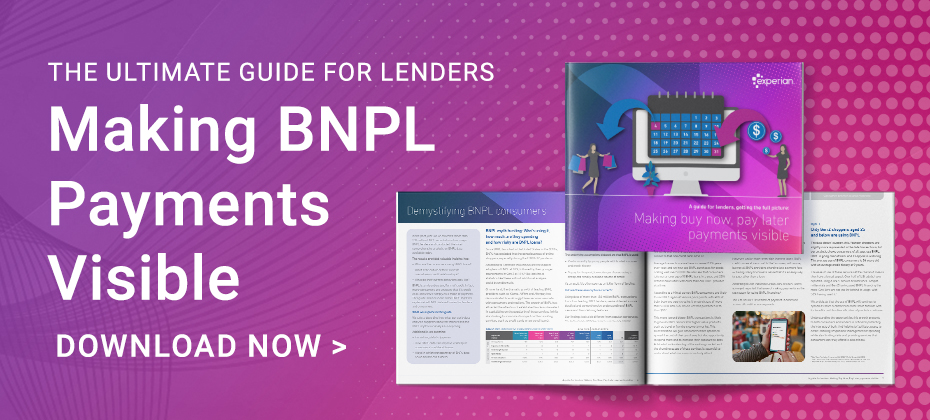Fintech
Fintech

To reach customers in our modern, diverse communications landscape, it's not enough to send out one-size-fits-all marketing messages. Today's consumers value and continue to do business with organizations that put them first. For financial institutions, this means providing personalized experiences that enable your customers to feel seen and your marketing dollars to go further. How can you achieve this? The answer is simple: a customer-driven credit marketing strategy. What is customer-driven marketing? Customer-driven marketing is a strategy that focuses on putting consumers first, rather than products. It means thinking about the needs, wants and motivations of the prospects you're trying to reach and centering your marketing campaigns and messages around that audience. When done well, this comprehensive approach extends beyond the marketing team to all members of a company. The benefits of customer-driven credit marketing One benefit of this type of personalized credit marketing is that you can target customers with a potentially higher lifetime value. By focusing your marketing efforts on the right prospects, you'll ensure that budgets are being spent wisely and that you're not wasting valuable marketing dollars communicating with consumers who either won't respond or aren't a fit for your business. Customer-driven marketing enables you to identify and reach the most profitable, highly responsive prospects in the most efficient way, while also engaging with current customers to optimize retention rates. When you create marketing programs that are customer-driven, you're not just selling; you're building relationships. Rather than being simply a service provider, you become a trusted financial partner and advisor. This kind of data-driven customer experience can help you onboard more customers and retain them for longer, translating to better results when it comes to your bottom line. Customer-driven marketing: How to get started Customer-driven marketing is less funnel, more spiral. You research, test, refine and repeat, all while taking into account customer feedback and campaign results. It starts with defining your target audience and creating customer personas. As you do this, think about all the factors that are involved in your target customers’ path to purchase, from general awareness and growing need to the final motivation that pushes them to commit. You'll also want to consider what their pain points may be and the barriers that may prevent them from buying. Next, develop a marketing strategy that aligns with your target customers' needs and outlines how and where you'll reach them. It may also be helpful to gather and respond to customer feedback to ensure the value propositions in your campaigns are aligned with customer expectations. These insights can help you refine your messaging, resulting in increased response and retention rates. Use the right data to extend relevant credit offers When you send credit offers, you want to ensure they're reaching the right prospects at the right time. You also want to make sure these credit offers are relevant to the consumers that receive them. That's where quality data comes in. By optimizing your data-driven customer segmentation, you can develop timely and personalized credit offers to boost response rates. For example, you might have a target audience of consumers who are both creditworthy and looking for a new vehicle. Segmenting this audience into smaller groups by demographic, life stage, financial and other factors helps you create credit marketing campaigns that speak to each type of customer as an individual, not just a number. Meet consumers on their preferred channels Nowadays, consumer behavior is more fragmented than ever. This is relevant not just from a demographic point of view, but from the perspective of purchasing behavior. Customer-driven marketing helps you interact with prospects as individuals so that the value propositions they encounter are a true fit for their life situation. For instance, different age groups tend to spend time on different platforms. But why they're on those channels at any particular time matters too. Messaging aimed at prospects in their leisure time should be different from messaging they'll encounter when actively researching potential purchases. Keep up with your customers This is one answer to the question of how to improve customer retention as well. Research demonstrates that it's more cost-effective to keep a customer than to acquire a new one. When you tailor retention efforts with a well-thought-out customer-driven marketing strategy, you're likely to boost retention rates, which in many cases lead to better profits over time. Importance of a customer-driven marketing strategy Putting consumers at the center of credit marketing strategies — and at the center of your business as a whole — is the foundation for personalized experiences that can ultimately increase response rates and customer satisfaction. For more on how your organization can develop an effective customer-driven marketing strategy, learn about our credit marketing solutions.

The rise of the digital channel lead to a rise in new types of fraud – like cryptocurrency and buy now, pay later scams. While the scams themselves are new, they’re based on tried-and-true schemes like account takeover and synthetic identity fraud that organizations have been working to thwart for years, once again driving home the need for a robust fraud solution. While the digital channel is extremely attractive to many consumers due to convenience, it represents a balancing act for organizations – especially those with outdated fraud programs who are at increased risk for fraud. As organizations look for ways to keep themselves and the consumers they serve safe, many turn to fraud risk mitigation. What are fraud risk management strategies? Fraud risk management is the process of identifying, understanding, and responding to fraud risks. Proper fraud risk management strategies involve creating a program that detects and prevents fraudulent activity and reduces the risks associated with fraud. Many fraud risk management strategies are built on five principles: Fraud Risk AssessmentFraud Risk GovernanceFraud PreventionFraud DetectionMonitoring and Reporting By understanding these principles, you can build an effective strategy that meets consumer expectations and protects your business. Fraud risk assessment Fraud protection begins with an understanding of your organization’s vulnerabilities. Review your top risk areas and consider the potential losses you could face. Then look at what controls you currently have in place and how you can dial those up or down to impact both risk and customer experience. Fraud risk governance Fraud risk governance generally takes the form of a program encompassing the structure of rules, practices, and processes that surround fraud risk management. This program should include the fraud risk assessment, the roles and responsibilities of various departments, procedures for fraud events, and the plan for on-going monitoring. Fraud prevention “An ounce of prevention is worth a pound of cure.” This adage certainly rings true when it comes to fraud risk management. Having the right controls and procedures in place can help organizations stop a multitude of fraud types before they even get a foot in the door. Account takeover fraud prevention is an ideal example of how organizations can keep themselves and consumers safe. Fraud detection The only way to stop 100% of fraud is to stop 100% of interactions. Since that’s not a sustainable way to run a business, it’s important to have tools in place to detect fraud that’s already entered your ecosystem so you can stop it before damage occurs. These tools should monitor your systems to look for anomalies and risky behaviors and have a way to flag and report suspicious activity. Monitoring and reporting Once your fraud detection system is in place, you need active monitoring and reporting set up. Some fraud detection tools may include automatic next steps for suspicious activity such as step-up authentication or another risk mitigation technique. In other cases, you’ll need to get a person involved. In these cases it’s critical to have documented procedure and routing in place to ensure that potential fraud is assessed and addressed in a timely fashion. How to implement fraud risk management By adhering to the principles above, you can gain a holistic view of your current risk level, determine where you want your risk level to be, and what changes you’ll need to make to get there. While you might already have some of the necessary tools in place, the right next step is usually finding a trusted partner who can help you review your current state and help you use the right fraud prevention services that fit your risk tolerance and customer experience goals. To learn more about how Experian can help you leverage fraud prevention solutions, visit us or request a call. Learn more

With nearly seven billion credit card and personal loan acquisition mailers sent out last year, consumers are persistently targeted with pre-approved offers, making it critical for credit unions to deliver the right offer to the right person, at the right time. How WSECU is enhancing the lending experience As the second-largest credit union in the state of Washington, Washington State Employees Credit Union (WSECU) wanted to digitalize their credit decisioning and prequalification process through their new online banking platform, while also providing members with their individual, real-time credit score. WSECU implemented an instant credit decisioning solution delivered via Experian’s Decisioning as a ServiceSM environment, an integrated decisioning system that provides clients with access to data, attributes, scores and analytics to improve decisioning across the customer life cycle. Streamlined processes lead to upsurge in revenue growth Within three months of leveraging Experian’s solution, WSECU saw more members beginning their lending journey through a digital channel than ever before, leading to a 25% increase in loan and credit applications. Additionally, member satisfaction increased with 90% of members finding the simplified process to be more efficient and requiring “low effort.” Read our case study for more insight on using our digital credit solutions to: Prequalify members in real-time at point of contact Match members to the right loan products Increase qualification, approval and take rates Lower operational and manual review costs Read case study

BNPL is a misunderstood form of credit. In fact, many consumers are unaware that it is credit at all and view it simply as a mode of payment. This guide debunks common BNPL myths to explain what BNPL data will mean for lenders and consumers. In the past year, Experian collected more than 130 million buy now, pay later (BNPL) records from four major BNPL fintech lenders and conducted the most comprehensive analysis of BNPL data available today. The results provided valuable insights on: Who are the consumers using BNPL loans? What is the nature of their current mainstream credit relationships? What do their current BNPL behaviors look like? BNPL myth-busting: Who’s using it, how much are they spending and how risky are BNPL loans? Since BNPL launched in the United States in the 2010s, BNPL has exploded into the consciousness of online shoppers, especially during the COVID-19 pandemic. According to Forrester, Millennials are the biggest adopters of BNPL at 18%, followed by their younger counterparts in Gen Z at 11%.1 But looking at statistics like these without additional analysis could be problematic. The dramatic growth of leading BNPL fintechs such as Klarna, Affirm and Afterpay has demonstrated how strongly these services resonate with consumers and retailers. The growth of BNPL has attracted the attention of established lenders interested in capitalizing on the popularity of these services (while also looking to minimize its impact on their existing services, such as credit cards or personal loans). Meanwhile, the Consumer Financial Protection Bureau (CFPB) has urged caution about potential risks, calling for more consistent consumer protections market-wide and transparency into consumer debt accumulation and overextension across lenders. The underlying assumptions debated are that BNPL is used: Predominantly by young people with limited incomes and credit history To pay for frequent, low-value purchases using a cheap and readily available source of credit As a result, it is often seen as a riskier form of lending. But are these assumptions correct? Using data from more than 130 million BNPL transactions from four leading BNPL fintech lenders, we’ve obtained a more detailed and comprehensive understanding of BNPL users and their defining features. Our findings look somewhat different to the popular stereotypes. Myth 1: BNPL is used only for low-value purchases According to our analysis, most BNPL purchases, 95 percent are for items costing $300 or less.2 Some of it is low-value, but not all. In fact, we found that the average purchase using BNPL was similar to that of a credit card, at $132.Average transaction sizes have increased 10 percent year-over-year, and we now see BNPL purchases for goods costing well over $1,000. We also see that consumers take out an average of 5 BNPL loans in a year and 23 percent of them have loans with more than one BNPL provider at a time. Myth 2: BNPL is simply an easier payment method Consumers see BNPL as a simple, quick and convenient way to pay. But, as shoppers receive goods for which payment is deferred, it’s also a form of credit. However, unlike short-term high-interest loans, BNPL credit comes at zero cost to the borrower, with some, but not all BNPL fintech providers charging late payment fees – fueling many borrowers’ sense that it’s an easy way to pay, rather than a loan. Myth 3: Only Gen Z shoppers aged 25 and below are using BNPL Younger shoppers are slightly more represented in the data transactions, but our analysis shows consumers of all ages use BNPL. BNPL is going mainstream, and its appeal is widening. The average age of BNPL consumers is 36 years old, with an average credit history of 9 years.2 The ease of use of these services at the checkout means they have a broad appeal. Over half of U.S. adults have reported using a BNPL service at least once. Despite Millennials and Gen Z having used BNPL financing the most, Gen Xers are not too far behind in usage, with 52% having used it.2 We anticipate that in the use of BNPL will continue to grow as more customers become more familiar with the benefits, and the diversification of products continues. Understanding the opportunities this growth presents to both consumers and lenders is critical to protecting their interests. And helping to facilitate access to credit, enabling responsible spending, while also limiting risks and providing services that consumers can afford is also critical. Download the full guide for additional myths we’re exposing We will take a deep dive into what our early data analysis suggests about the market and the BNPL myths our analysis is exposing. Additionally, we will examine: Why BNPL data matters to providers and lenders How BNPL data can improve visibility of consumers’ creditworthiness Ways in which transparency of BNPL data could benefit consumers 1The Buy Now, Pay Later (BNPL) Opportunity,” Forrester Report, April 29, 2022.2Experian data and analytics derived from 130M+ BNPL transactions

There’s an undeniable link between economic and fraud trends. During times of economic stress, fraudsters engage in activities specifically designed to target strained consumers and businesses. By layering risk management and fraud prevention tools, your organization can manage focus on growing safely. Download infographic Review your fraud strategy

What Is Identity Proofing? Identity proofing, authentication and management are becoming increasingly complex and essential aspects of running a successful enterprise. Organizations need to get identity right if they want to comply with regulatory requirements and combat fraud. It's also becoming table stakes for making your customers feel safe and recognized. 63 percent of consumers expect businesses to recognize them online, and 48 percent say they're more trusting of businesses when they demonstrate signs of security. Identify proofing is the process organizations use to collect, validate and verify information about someone. There are two goals — to confirm that the identity is real (i.e., it's not a synthetic identity) and to confirm that the person presenting the identity is its true owner. The identity proofing process also relates to and may overlap with other aspects of identity management. Identity proofing vs identity authentication Identity proofing generally takes place during the acquisition or origination stages of the customer lifecycle — before someone creates an account or signs up for a service. Identity authentication is the ongoing process of re-checking someone's identity or verifying that they have the authorization to make a request, such as when they're logging into an account or trying to make a large transaction. How does identity proofing work? Identity proofing typically involves three steps: resolution, validation, and verification. Resolution: The goal of the first step is to accurately identify the single, unique individual that the identity represents. Resolution is relatively easy when detailed identity information is provided. In the real world, collecting detailed data conflicts with the need to provide a good customer experience. Resolution still has to occur, but organizations have to resolve identities with the minimum amount of information. Validation: The validation step involves verifying that the person's information and documentation are legitimate, accurate and up to date. It potentially involves requesting additional evidence based on the level of assurance you need. Verification: The final step confirms that the claimed identity actually belongs to the person submitting the information. It may involve comparing physical documents or biometric data and liveness tests, such as a comparison of the driver's license to a selfie that the person uploads. Different levels of identity proofing may require various combinations of these steps, with higher-risk scenarios calling for additional checks such as biometric or address verification. Service providers can implement a range of methods based on their specific needs, including document verification, database validation, or knowledge-based authentication. Building an effective identity proofing strategy By requiring identity proofing before account opening, organizations can help detect and deter identity fraud and other crimes. You can use different online identity verification methods to implement an effective digital identity proofing and management system. These may include: Document verification plus biometric data: The consumer uploads a copy of an identification document, such as a driver's license, and takes a selfie or records a live video of their face. Database validations: The proofing solution verifies the shared identifying information, such as a name, date of birth, address and Social Security number against trusted databases, including credit bureau and government agency data. Knowledge-based authentication (KBA): The consumer answers knowledge-based questions, such as account information, to confirm their identity. It can be a helpful additional step, but they offer a low level of assurance, partially because data breaches have exposed many people's personal information. In part, the processes you'll use may depend on business policies, associated risks and industry regulations, such as know your customer (KYC) and anti-money laundering (AML) requirements. But organizations also have to balance security and ease of use. Each additional check or requirement you add to the identity proofing flow can help detect and prevent fraud, but the added friction they bring to your onboarding process can also leave customers frustrated — and even lead to customers abandoning the process altogether. Finding the right amount of friction can require a layered, risk-based approach. And running different checks during identity proofing can help you gauge the risk involved. For example, comparing information about a device, such as its location and IP address, to the information on an application. Or sending a one-time password (OTP) to a mobile device and checking whether the phone number is registered to the applicant's name. With the proper systems in place, you can use high-risk signals to dynamically adjust the proofing flow and require additional identity documents and checks. At the same time, if you already have a high level of assurance about the person's identity, you can allow them to quickly move through a low-friction flow. Experian goes beyond identity proofing Experian builds on its decades of experience with identity management and access to multidimensional data sources to help organizations onboard, authenticate and manage customer identities. Our identity proofing solutions are compliant with National Institute of Standards and Technology (NIST) and enable agencies to confidently verify user identities prior to or during account opening, biometric enrollment or while signing up for services. Learn more This article includes content created by an AI language model and is intended to provide general information.

Machine learning (ML) is a powerful tool that can consume vast amounts of data to uncover patterns, learn from past behaviors, and predict future outcomes. By leveraging ML-powered credit risk models, lenders can better determine the likelihood that a consumer will default on a loan or credit obligation, allowing them to score applicants more accurately. When applied to credit decisioning, lenders can achieve a 25 percent reduction in exposure to risky customers and a 35 percent decrease in non-performing loans.1 While ML-driven models enable lenders to target the right audience and control credit losses, many organizations face challenges in developing and deploying these models. Some still rely on traditional lending models with limitations preventing them from making fast and accurate decisions, including slow reaction times, fewer data sources, and less predictive performance. With a trusted and experienced partner, financial institutions can create and deploy highly predictive ML models that optimize their credit decisioning. Case study: Increase customer acquisition with improved predictive performance Looking to meet growth goals without increasing risk, a consumer goods retailer sought out a modern and flexible solution that could help expand its finance product options. This meant replacing existing ML models with a custom model that offers greater transparency and predictive power. The retailer partnered with Experian to develop a transparent and explainable ML model. Based on the model’s improved predictive performance, transparency, and ability to derive adverse action reasons for declines, the retailer increased sales and application approval rates while reducing credit risk. Read the case study Learn about our custom modeling capabilities 1 Experian (2020). The Art of Decisioning in Uncertain Times

"Out with the old and in with the new" is often used when talking about a fresh start or change we make in life, such as getting a new job, breaking bad habits or making room in our closets for a new wardrobe. But the saying doesn't exactly hold true in terms of business growth. While acquiring new customers is critical, increasing customer retention rates by just 5% can increase profits by up to 95%.1 So, what can your organization do to improve customer retention? Here are three quick tips: Stay informed Keeping up with your customers’ changing interests, behaviors and life events enables you to identify retention opportunities and create personalized credit marketing campaigns. Are they new homeowners? Or likely to purchase a vehicle within the next five months? With a comprehensive consumer database, like Experian’s ConsumerView®, you can gain granular insights into who your customers are, what they do and even what they will potentially do. To further stay informed, you can also leverage Retention TriggersSM, which alert you of your customers changing credit needs, including when they shop for new credit, open a new trade or list their property. This way, you can respond with immediate and relevant retention offers. Be more than a business – be human Gen Z's spending power is projected to reach $12 trillion by 2030, and with 67% looking for a trusted source of personal finance information,2 financial institutions have an opportunity to build lifetime loyalty now by serving as their trusted financial partners and advisors. To do this, you can offer credit education tools and programs that empower your Gen Z customers to make smarter financial decisions. By providing them with educational resources, your younger customers will learn how to strengthen their financial profiles while continuing to trust and lean on your organization for their credit needs. Think outside the mailbox While direct mail is still an effective way to reach consumers, forward-thinking lenders are now also meeting their customers online. To ensure you’re getting in front of your customers where they spend most of their time, consider leveraging digital channels, such as email or mobile applications, when presenting and re-presenting credit offers. This is important as companies with omnichannel customer engagement strategies retain on average 89% of their customers compared to 33% of retention rates for companies with weak omnichannel strategies. Importance of customer retention Rather than centering most of your growth initiatives around customer acquisition, your organization should focus on holding on to your most profitable customers. To learn more about how your organization can develop an effective customer retention strategy, explore our marketing solutions. Increase customer retention today 1How investing in cardholder retention drives portfolio growth, Visa. 2Experian survey, 2023.

Alternative credit scoring has become mainstream. Lenders that use alternative credit scores can find opportunities to expand their lending universe without taking on additional risk and more accurately assess the credit risk of traditionally scoreable consumers. Obtaining a more holistic consumer view can help lenders improve automation and efficiency throughout the customer lifecycle. What is alternative credit scoring? Alternative credit scoring models incorporate alternative credit data* that isn't typically found on consumer credit reports. These scores aren't necessarily trying to predict alternative outcomes. The goal is the same — to understand the likelihood that a borrower will miss payments in the future. What's different is the information (and sometimes the analytical techniques) that inform these predictions.Traditional credit scoring models solely consider information found in consumer credit reports. There's a lot of information there — Experian's consumer credit database has data on over 245 million consumers. But although traditional consumer data can be insightful, it doesn't necessarily give lenders a complete picture of consumers' creditworthiness. Alternative credit scores draw from additional data sources, including: Alternative financial services: Credit data from alternative financial services (AFS) can tell you about consumers' experiences with small-dollar installment loans, single-payment loans, point-of-sale financing, auto title loans and rent-to-own agreements. Buy Now Pay Later: Buy Now Pay Later (BNPL) borrowing is popular with consumers across the scoring spectrum, and lenders can use access to open BNPL loans to better assess consumers' current capacity. Rental payments: Landlords, property managers, collection companies, rent payment services and consumer-permissioned data can give lenders access to consumers' rent payment history. Full-file public records: Credit reports generally only include bankruptcy records from the previous seven to ten years. However, lenders with access to full-file public records can also learn about consumers' property deeds, address history, and professional and occupational licenses. READ: Take a deep dive into Experian's State of Alternative Credit Data report to learn more about the different types of alternative credit data and uses across the loan lifecycle. With open banking, consumers can now easily and securely share access to their banking and brokerage account data — and they're increasingly comfortable doing so. In fact, 70% would likely share their banking data for better loan rates, financial tools or personalized spending insights.Tools like Experian Boost allow consumers to add certain types of positive payment information to their Experian credit reports, including rent, utility and select streaming service payments. Some traditional scores consider these additional data points, and users have seen their FICO Score 8 from Experian boosted by an average of 13 points.1 Experian Go also allows credit invisible consumers to establish a credit report with consumer-permissioned alternative data. The benefits of using alternative credit data The primary benefit for lenders is access to new borrowers. Alternative credit scores help lenders accurately score more consumers — identifying creditworthy borrowers who might otherwise be automatically denied because they don't qualify for traditional credit scores. The increased access to credit may also align with lenders' financial inclusion goals.Lenders may additionally benefit from a more precise understanding of consumers who are scoreable. When integrated into a credit decisioning platform, the alternative scores could allow lenders to increase automation (and consumers' experiences) without taking on more credit risk. The future of alternative credit scoring Alternative credit scoring might not be an alternative for much longer, and the future looks bright for lenders who can take advantage of increased access to data, advanced analytics and computing power.Continued investment in alternative data sources and machine learning could help bring more consumers into the credit system — breaking barriers and decreasing the cost of basic lending products for millions. At the same time, lenders can further customize offers and automate their operations throughout the customer lifecycle. Partnering with Experian Small and medium-sized lenders may lack the budget or expertise to unlock the potential of alternative data on their own. Instead, lenders can turn to off-the-shelf alternative models that can offer immediate performance lifts without a heavy IT investment.Experian's Lift PlusTM score draws on industry- leading mainstream credit data and FCRA-regulated alternative credit data to provide additional consumer behavior insights. It can score 49% of mainstream credit-invisible consumers and for thin file consumers with a new trade, a 29% lift in scoreable accounts. Learn more about our alternative credit data scoring solutions. Learn more * When we refer to “Alternative Credit Data," this refers to the use of alternative data and its appropriate use in consumer credit lending decisions as regulated by the Fair Credit Reporting Act (FCRA). Hence, the term “Expanded FCRA Data" may also apply in this instance and both can be used interchangeably.1Experian (2023). Experian Boost

E-commerce digital transactions are rapidly increasing with global ecommerce sales forecast to grow to $7.89 trillion by 2028. While in-store shopping still earns more sales dollars than online shopping, consumers spent more than 18% of total average retail spend from e-commerce during the first half of 2025. Additionally, mobile technology and AI are major drivers of ecommerce growth, with mobile phones accounting for 77% of ecommerce website visits, and nearly 60% of U.S. shoppers turning to AI engines for help, even when online stores embed generative AI tools ton their websites. As a result, opportunities for fraudsters to exploit businesses and consumers for monetary gain are reaching high levels. Businesses must be aware of the risks associated with card not present (CNP) fraud and take steps to protect themselves and their customers. What is card not present fraud? CNP fraud occurs when a criminal uses a stolen or compromised credit card to make a purchase online, over the phone, or through some other means where the card is not physically present at the time of the transaction. This type of fraud can be particularly difficult to detect and prevent, as it relies on the use of stolen card information rather than the physical card itself. CNP fraud can yield significant losses for businesses — these attacks are estimated to reach a staggering $28 billion in losses by 2026. Many have adopted various fraud prevention and identity resolution and verification tools to better manage risk and prevent fraud losses. Since much of the success or failure of e-commerce depends on how easy merchants make it for consumers to complete a transaction, incorporating CNP fraud prevention and identity verification tools in the checkout process should not come at the expense of completing transactions for legitimate customers. What do we mean by that? Let’s look at false declines. What is a false decline? False declines occur when legitimate transactions are mistakenly declined due to the business's fraud detection system incorrectly flagging the transaction as potentially fraudulent. This can not only be frustrating for cardholders, but also for merchants. Businesses may lose the sale and also be on the hook for any charges that result from the fraudulent activity. They can also result in damage to the business's reputation with customers. In either case, it is important for businesses to have measures in place to mitigate the risks of both. How can online businesses increase sales without compromising their fraud defense? One way to mitigate the risk of CNP fraud is to implement additional security measures at the time of transaction. This can include requiring additional verification information, such as a CVV code or a billing zip code to further authenticate the card holder’s identity. These measures can help to reduce the risk of CNP fraud by making it more difficult for fraudsters to complete a transaction. Machine learning algorithms can help analyze transaction data and identify patterns indicating fraudulent activity. These algorithms can be trained on historical data to learn what types of transactions are more likely to be fraudulent and then be used to flag potentially fraudulent transactions before it occurs. Businesses require data and technology that raise confidence in a shopper’s identity. Currently, the data merchants receive to approve transactions is not enough. A credit card owner verification solution like Experian Link fills this gap by enabling online businesses to augment their real-time decisions with data that links customer identity to the credit card being presented for payment to help verify the legitimacy of a transaction. Using Experian Link, businesses can link names, addresses and other identity markers to the customer’s credit card. The additional data enables better decisions, increased sales, decreased costs, a better buyer experience and better fraud detection. Get started with Experian Link™ - our frictionless credit card owner verification solution. Learn more

With an abundance of loan options in today’s market, retaining customers can be challenging for banks and credit unions, especially small or regional institutions. And as more consumers look for personalization and digital tools in their banking experience, the likelihood of switching to institutions that can meet these demands is increasing.1 According to a recent Experian survey, 78% of consumers have conducted personal banking activities online in the last three months. However, 58% of consumers don’t feel that businesses completely meet their expectations for a digital online experience. To remain competitive in today's market, organizations must enhance their prescreen efforts by accelerating their digital transformation. Prescreen in today's economic environment While establishing a strong digital strategy is crucial to meeting the demands of today’s consumers, economic conditions are continuing to change, causing many financial institutions to either tighten their marketing budgets or hold off on their prescreen efforts completely. Fortunately, lenders can still drive growth during a changing economy without having to make huge cuts to their marketing budgets. How? The answer lies in digital prescreen. Case study: Uncover hidden growth opportunities Wanting to grow their business and existing relationships, Clear Mountain Bank looked for a solution that could help them engage customers with money-saving product offers while delivering a best-in-class digital banking experience. Leveraging Digital Prescreen with Micronotes, the bank was able to identify and present dollarized savings to customers who held higher-priced loans with other lenders. What’s more, the bank extended these offers through personalized conversations within their online and mobile banking platforms, resulting in improved digital engagement and increased customer satisfaction. By delivering competitive prescreen offers digitally, Clear Mountain Bank generated more than $1 million in incremental loans and provided customers with an average of $1,615 in cost savings within the first two months of deployment. “Digital Prescreen with Micronotes supplied the infrastructure to create higher-quality, personalized offers, as well as the delivery and reporting. They made prescreen marketing a reality for us.” – Robert Flockvich, Director of Community Outreach and Retail Lending at Clear Mountain Bank To learn more about how you can grow your portfolio and customer relationships, read the full case study or visit us. Download the case study Visit us 1The Keys to Solving Banking’s Customer Loyalty & Retention Problems, The Financial Brand, 2022.

Financial institutions have gone through a whirlwind in the last few years, with the pandemic forcing many to undergo digital transformations. More recently, rising interest rates and economic uncertainty are leading to a pullback, highlighting the need for lenders to level up their marketing strategies to win new customers. To get started, here are a few key trends to look out for in the new year and fresh marketing ideas for lenders. Challenges and consumers expectations in 2023 It might be cliche to mention the impact that the pandemic had on digital transformations — but that doesn't make it any less true. Consumers now expect a straightforward online experience. And while they may be willing to endure a slightly more manual process for certain purchases in their life, that's not always necessary. Lenders are investing in front-end platforms and behind-the-scenes technology to offer borrowers faster and more intuitive services. For example, A McKinsey report from December 2021 highlighted the growth in nonbank mortgage lenders. It suggested nonbank lenders could hold onto and may continue taking market share as these tech-focused lenders create convenient, fast and transparent processes for borrowers.2 Marketers can take these new expectations to heart when discussing their products and services. To the extent you have one in place, highlight the digital experience that you can offer borrowers throughout the application, verifications, closing and loan servicing. You can also try to show rather than tell with interactive online content and videos. Build a data-driven mortgage lending marketing strategy The McKinsey report also highlighted a trend in major bank and nonbank lenders investing in proprietary and third-party technology and data to improve the customer experience.2 Marketers can similarly turn to a data-driven credit marketing strategy to help navigate shifting lending environments. Segment prospects with multidimensional data Successful marketers can incorporate the latest technological and multidimensional data sources to find, track and reach high-value prospects. By combining traditional credit data with marketing data and Fair Credit Report Act-compliant alternative credit data* (or expanded FCRA-regulated data), you can increase the likelihood of connecting with consumers who meet your credit criteria and will likely respond. For example, Experian's mortgage-specific In the Market Models predict a consumer's propensity to open a new mortgage within a one to four-month period based on various inputs, including trended credit data and Premier Attributes. You can use these propensity models as part of your prescreen criteria, to cross-sell current customers and to help retain customers who might be considering a new lender. But propensity models are only part of the equation, especially when you're trying to extend your marketing budget with hyper-segmented campaigns. Incorporating your internal CRM data and non-FCRA data can help you further distinguish look-alike populations and help you customize your messaging. LEARN MORE: Use this checklist to find and fix gaps in your prospecting strategy Maintain a single view of your borrowers An identity management platform can give you a single view of a consumer as they move through the customer journey. The persistent identity can also help you consistently reach consumers in a post-cookie world and contact them using their preferred channel. You can add to the persistent identity as you learn more about your prospects. However, you need to maintain data accuracy and integrity if you want to get a good ROI. Use triggers to guide your outreach You can also use data-backed credit triggers to implement your marketing plan. Experian's Prospect Triggers actively monitors a nationwide database to identify credit-active consumers who have new tradelines, inquiries or a loan nearing term. Lenders using Prospect Triggers can receive real-time or periodic updates and customize the results based on their screening strategy and criteria, such as score ranges and attributes. They can then make firm credit offers to the prospects who are most likely to respond, which can improve cross-selling opportunities along with originations. Benefit from our expertise Forward-thinking lenders should power their marketing strategies with a data-backed approach to incorporate the latest information from internal and external sources and reach the right customer at the right time and place. From list building to identity management and verification, you can turn to Experian to access the latest data and analytics tools. Learn about Experian credit prescreen and marketing solutions. Explore our credit prescreen solutions Learn about our marketing solutions 1Mortgage Bankers Association (October 2022). Mortgage Applications Decrease in Latest MBA Weekly Survey 2McKinsey & Company (2021). Five trends reshaping the US home mortgage industry

The collections landscape is changing due to shifting consumer behaviors, demands, regulations and an economy that’s in a constant state of flux. As the market evolves, the need for greater insight and analysis grows. Matthew Baltzer, Experian’s Senior Director of Product Marketing, discusses challenges facing the collections industry and how you can continue to build a profitable portfolio. For more information on enhancing your collections strategy, view our full Q&A video. Q: Which macroeconomic trends should debt collectors be the most aware of and why? A:While we are still seeing a reasonably healthy consumer, there are trends to monitor. The first would be employment, which continues to be strong. Laid-off individuals are typically able to move back into the labor force. Second, we're seeing strong consumer spending, with rates higher than in the past three years and high origination activity. A third is declining savings rates. During the pandemic, consumers stored away extra cash, which has since come to a halt. Part of that is likely due to inflation, but it could also point to signs of financial strain. Q: How could these trends impact debt collections strategies moving forward? A: At a portfolio level, they’re good news. The average consumer’s ability to pay has yet to degrade significantly. So, collectors should be able to continue collecting payments. However, six months from now, the impact of inflation and interest rates could take a toll, and settlement offers, or higher upfront payments, may be important tools to consider. Due to increasing interest rates, many households will send money to creditors, leaving less for everyday spending. Q: How has the average consumer been affected by inflation? A: As I mentioned, both consumer spending and overall debt are up. However, when it comes to spending, certain ‘categories’ are more impacted by inflation than others. Of course, home equity and mortgages are higher, which while important, is less impactful for debt collectors. In our recent webinar, ‘Economic Outlook and the Influence on Debt Collections,’ we highlighted the uneven impact inflation has on lower earners in categories such as rent, food and energy. Due to this, collectors may see a rise in delinquency rates, particularly in unsecured personal loans and potentially automotive loans. Q: How should consumers' response to inflation impact collections efforts? A: There may be an increase in opportunities in certain trades, such as utilities, automotive and unsecured personal loans. Are you positioned as an organization to target and serve those markets? For those in the industry, the real potential for an economic weakness should present an opportunity to evaluate your collection strategy. How will you adapt to a 20 to 30% increase in volume? What about working accounts with smaller balances, which we've seen more of since the last larger recession? Experian offers software and decisioning solutions that help debt collectors optimize their strategies for an improved return on investment. Q: What consumer specific data can help lenders better predict distressed consumers? A: As an originator, the first approach to consider should be leveraging new types of data that were not available during the last recession, such as trended, third-party and alternative credit data. Supplementary data can provide leading indicators that risk is increasing before a consumer goes delinquent and their accounts are past due. Additionally, advanced analytics scoring models can help you determine which accounts are more likely to be recoverable. Experian has a new scoring model that uses a complex blend of attributes to assess each trade's history and position in wallet to better predict the likelihood of that account self-curing and separate accounts that need the most attention from those that may need more time. Finally, with accurate consumer contact data, you can enhance your digital engagement strategy and reach the right person, at the right time, on the channel they prefer There’s no time like the present to equip yourself with a successful debt management strategy. With a more holistic consumer view, you can improve account prioritization, predictability and right-party contact rates. Learn more about our debt management solutions here. Watch on-demand webinar

With consumers having more credit options than ever before, it’s imperative for lenders to get their message in front of ideal customers at the right time and place. But without clear insights into their interests, credit behaviors or financial capacity, you may risk extending preapproved credit offers to individuals who are unqualified or have already committed to another lender. To increase response rates and reduce wasted marketing spend, you must develop an effective customer targeting strategy. What makes an effective customer targeting strategy? A customer targeting strategy is only as good as the data that informs it. To create a strategy that’s truly effective, you’ll need data that’s relevant, regularly updated, and comprehensive. Alternative data and credit-based attributes allow you to identify financially stressed consumers by providing insight into their ability to pay, whether their debt or spending has increased, and their propensity to transfer balances and consolidate loans. With a more granular view of consumers’ credit behaviors over time, you can avoid high-risk accounts and focus only on targeting individuals that meet your credit criteria. While leveraging additional data sources can help you better identify creditworthy consumers, how can you improve the chances of them converting? At the end of the day, it’s also the consumer that’s making the decision to engage, and if you aren’t sending the right offer at the precise moment of interest, you may lose high-value prospects to competitors who will. To effectively target consumers who are most likely to respond to your credit offers, you must take a customer-centric approach by learning about where they’ve been, what their goals are, and how to best cater to their needs and interests. Some types of data that can help make your targeting strategy more customer-centric include: Demographic data like age, gender, occupation and marital status, give you an idea of who your customers are as individuals, allowing you to enhance your segmentation strategies. Lifestyle and interest data allow you to create more personalized credit offers by providing insight into your consumers’ hobbies and pastimes. Life event data, such as new homeowners or new parents, helps you connect with consumers who have experienced a major life event and may be receptive to event-based marketing campaigns during these milestones. Channel preference data enables you to reach consumers with the right message at the right time on their preferred channel. Target high-potential, high-value prospects By using an effective customer targeting strategy, you can identify and engage creditworthy consumers with the greatest propensity to accept your credit offer. To see if your current strategy has what it takes and what Experian can do to help, view this interactive checklist or visit us today. Review your customer targeting strategy Visit us

Whether your goal is to gain new business or create cross-sell opportunities, being proactive in your credit marketing approach can help drive higher response rates and more meaningful customer experiences. But without knowing when your ideal customers are actively seeking credit, you may risk losing business to lenders who have already engaged. So, how can you identify new opportunities when they occur? Given that 91% of consumers say they’re more likely to shop with brands that provide relevant offers, you’ll need to reach the right consumers at the right moment to increase response rates and stay ahead of competitors. Event-based credit triggers can help you identify new tradelines, inquiries and certain loans nearing term to locate highly responsive, credit-active individuals. By receiving updates on consumers’ recent credit activities, you can make firm credit offers immediately so you never miss an opportunity. Case Study: Deliver timely offers with credit trigger leads Vantage West Credit Union serves over 170,000 members across Arizona. With their members looking elsewhere for their mortgage needs, Vantage West aimed to drive as many of these members back to the credit union as possible. To do this, they looked for a solution that could help them identify and target members who are in the market for a new mortgage. By augmenting their prescreen process with Experian’s Prospect Triggers for mortgages, the credit union was able to quickly pinpoint consumers that not only met their credit criteria but were also likely to respond to their credit offers. Within two years of implementing Prospect Triggers, Vantage West funded an additional $18 million in mortgages and is continuing to grow by making timely offers to credit-active prospects. Prospect Triggers is available for banks, credit card issuers, mortgage lenders, retailers and automotive lenders. To learn how Experian can help bring precision and profitability to your credit marketing campaigns, read the full case study or visit us. Download the case study Visit us